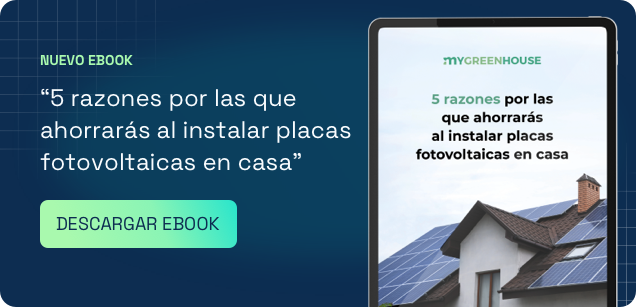Solar batteries are a good way to get the most out of your photovoltaic installation. Not only will they help you cut your electricity costs, but they’ll also bring you closer to an almost totally independent self-consumption model.
Even though solar batteries are an excellent resource to achieve maximum profitability, we’ll tell you exactly what you need to know in order to decide whether you should install them or not.
When to install solar batteries in your system?
By adding solar batteries, you’ll be able to harness all the energy generated by your photovoltaic panels.
As you know, the amount and quality of sunlight varies considerably throughout the year, even on the same day. However, batteries will guarantee power supply during the night, on cloudy days, or during peak consumption times.
But what factors should you consider before installing batteries in your photovoltaic system?
Energy consumption curve
If you consume energy at the same time that you’re generating it (for example, people who work from home or spend a lot of time there), then batteries may not be cost-effective, as it will take longer to recoup the initial investment.
If, on the other hand, you consume energy when your photovoltaic panels aren’t producing it (at night, for example), then batteries are the best option for exploiting energy production.
This second consumer group corresponds to adults and/or families with small children who spend a significant part of the day away from home.
Financial investment
Batteries increase the overall cost of a photovoltaic system. And, even though the energy savings are high with a properly designed system, the payback time also increases.
Taking into account the two profiles we’ve mentioned, in the first case (people who work from home or spend a lot of time there), most of the energy generated during the day will be automatically consumed, so there won’t be enough surplus to make it worth storing.
In the second case, however, you’ll obtain high energy savings (between 60 and 90%), and so installing solar batteries is an attractive option.
System performance
Taking into account your available roof space, you can choose how many panels you install, which will, in turn, influence the amount of energy you produce.
If space is limited, your system’s capacity will probably be low and you won’t be able to produce a surplus, so it doesn’t make sense to install accumulators either.
Types of batteries
The type of battery is crucial in order to get the most out of your photovoltaic installation.
Depending on the materials they’re made from, we can define three different types of solar batteries:
1. Monobloc batteries (open acid, AGM, or gel)
Open lead acid monobloc batteries are the most common, and are a recommended and economical model for low and medium power self-consumption solar installations. They’re particularly popular in caravans, camper vans, small houses, and storage or tool sheds.
Monobloc AGM and gel batteries have gelled electrolyte, and deliver a higher performance.
They can be used in complex or power intensive situations (solar installations with motor-driven technological devices, such as washing machines or water pumps), as they can handle high starting peaks.
Depending on the charge and discharge, the life cycles of monobloc batteries can be outlined as follows:
- Gel monobloc batteries > +1100 charge cycles
- AGM monobloc batteries > +500 charge cycles
- Open lead-acid monobloc batteries > +350 charge cycles
2. Stationary batteries (open lead acid and gel)
Recommended for medium and high consumption photovoltaic installations, stationary batteries have a useful life of around 20 years, thanks to the tubular plate inside them, which means they’re more resistant to continuous charge-discharge cycles than monobloc batteries.
Depending on their storage capacity and durability, there are different types of stationary batteries, with open lead acid and gel batteries being the most widely available.
The latter require less maintenance, although both are recommended for homes, farms or domestic installations.
3. Lithium batteries
Lithium batteries are very durable and require little maintenance.
They are cost-effective in the long term thanks to their greater charge and discharge depth (close to 90% of their capacity), and are noteworthy for their compact size.
These batteries have integrated intelligent management, last 6500 charge cycles, and are classified according to their voltage (Low Voltage – LV – and High Voltage – HV).
High Voltage, or HV, batteries are more efficient, although the choice depends on the inverter. With a hybrid inverter equipped with a backup option, you will need an HV battery; for the rest, you can use LV lithium batteries.
The main disadvantage of this type of battery is its price.
Furthermore, you will need to install several of them to handle the starting load of motor-driven appliances (washing machines, dishwashers, etc.).
Advantages and disadvantages of solar batteries
Advantages
- Having an accumulated energy reserve
- Having greater energy independence
- Reducing your ecological footprint by using less energy from the grid
- Encouraging innovation
- Contributing to the development of a more sustainable energy system
Disadvantages
- A higher investment
- Slower payback
- A more complex installation
- Higher maintenance costs
In other words, by adding solar batteries to our photovoltaic system we can achieve savings of 60-90% on our electricity bill, with a longer but more efficient amortisation of the investment. However, before you make a decision, you should make sure that you analyse the cost-benefit of the investment.
Besides this, it’s worth remembering that solar batteries have their own incentive and subsidy programme, as specified in the BOE (Official State Gazette). These subsidies are determined by the batteries’ storage capacity (5, 10 or 15 kWh) and their average discharge (one night, one day, one and a half days).
If you’re thinking of installing solar panels in your home, or upgrading your current photovoltaic installation to include batteries, don’t hesitate to get in touch with us. Here at My Green House, we’ll be happy to advise you and help you to find the best option.


